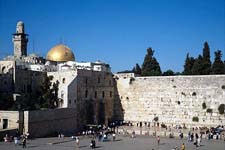|
Capital of
Judah and the site of the Temple.
|
Jerusalem
is located in central Palestine. Until the time
of David it was a Canaanite
village known as Jebus. David selected the city
to be his capital because the northern and southern
tribes had engaged in civil war after the death
of Saul. Jerusalem was centrally located and
had previously belonged to neither side. David's
soldiers captured the city by climbing a water
shaft and mounting a surprise attack (2 Sam
5:6-10). Jerusalem became the kingdom's religious
center when David brought the Ark
of the Covenant to the city and Solomon
built the first Temple. When the kingdom divided
in 922 B.C., Jerusalem remained the capital
of the southern kingdom of Judah. The Assyrians besieged Jerusalem
in the late eighth century B.C., but the city
did not fall. In 587 B.C. the Babylonians conquered
Jerusalem, destroyed its Temple, and exiled
many of its citizens. The exiles who returned
after 538 B.C. began the work of rebuilding
the Temple, the city, and its walls.
 |
Western wall of Temple platform
built by Herod the Great
1st cent. B.C. |
In New Testament
times, Jesus is said to have visited Jerusalem
as a child (Luke 2). According to John's gospel, Jesus came to Jerusalem
a number of times, teaching and working miracles. The other gospels suggest
that he made only one trip to Jerusalem during his ministry. Jesus was
crucified in Jerusalem and appeared to his disciples there after his resurrection
(Luke 24; John 20). Acts
relates that the disciples received the Holy Spirit in Jerusalem after
Jesus' ascension. The disciples taught, worked miracles, and engaged in
controversy in Jerusalem (Acts 2-5). Stephen
was martyred there (Acts 6-7). At a conference in Jerusalem it was agreed
that Gentile converts to Christianity did not need to be circumcised (Acts
15). At the end of his ministry Paul
was arrested in Jerusalem (Acts 21:17-22:30), imprisoned in Caesarea,
and finally sent to Rome. The Jerusalem Temple was destroyed in A.D. 70
in the Jewish revolt against Rome.
|